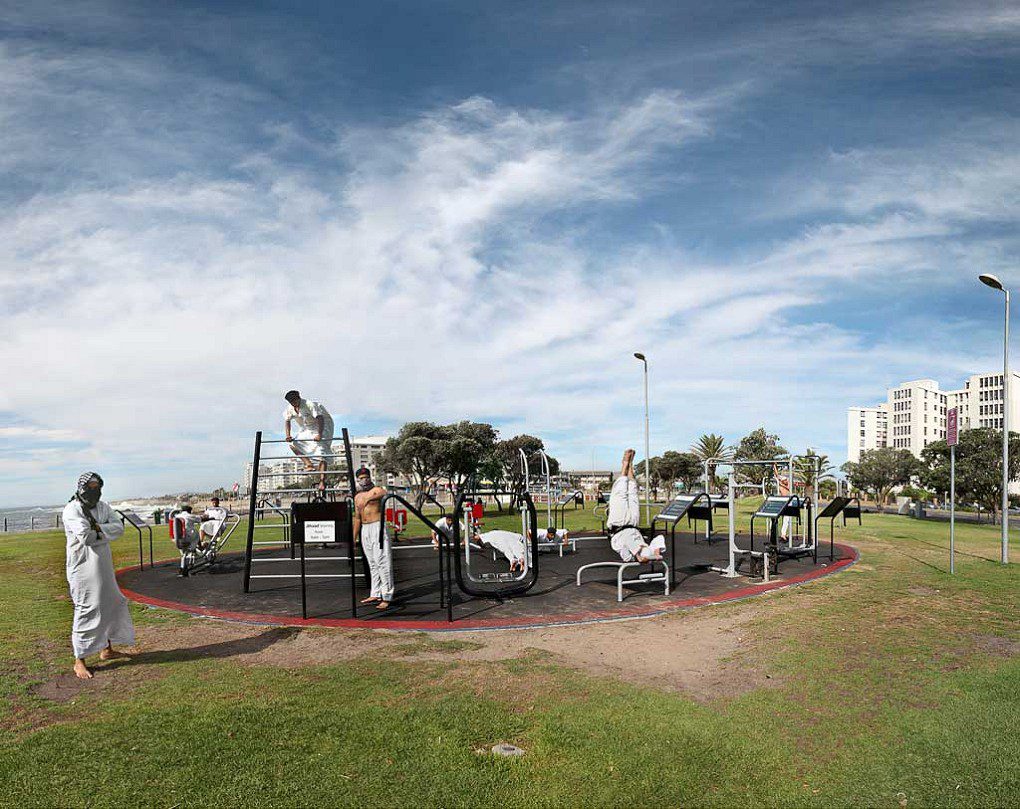Goodman Gallery, Cape Town, South Africa
25 Jun 2019 - 24 Aug 2019

Hasan and Husain Essop, 'Freedom Fighters', 2014, Lightjet C-print on archival paper, 115x145 cm / Image: 115x144 cm
The Wretched of the Screen seeks to engage in methods for documenting and counteracting the politics of the screen. Taking its title from the Hito Steyerl text of the same name, the exhibition explores Steyerl’s proposition that contemporary coherent political projects are fragmented and displaced by their transference onto screens.
Television has the ability to inform, distort, construct and define perceptions; the impact of mainstream media production can be easily underestimated, however, its consumption has a wide-ranging impact on politics, both personal and global. The ways in which bodies, identities and places are depicted on screen filter into ‘objective’ reality, allowing for the biases, misconceptions and outward prejudice of media producers to pervade daily life, and to lock in place pernicious stereotypes.
Mikhael Subtozky and Patrick Waterhouse’s From Televisions, Ponte City, Johannesburg (2008 – 2010) documents the television screens of each apartment in Ponte City — the building so known for criminal activities that it had earned an almost mythological notoriety in Johannesburg. This grid of ‘screens’ form a panopticon allowing a view into the daily lives of the residents, whose numbers had been nearly halved by evictions shortly before Subotzky and Waterhouse began documenting the building. The pair’s project engaged with the myths about Ponte City, but also worked hard to dispel them; the television screen are a domestic detail which create a relatable perception of the people who live there.
The nature of media-driven perception comes under scrutiny in Hasan and Husain Essops’ Freedom Fighters. The twin brothers collaborate in a practice that celebrates their religion while working to decode and destabilise negative perceptions of Islam. Here, they pose as Jihadists in training: a searing indictment of the media’s persistent association between their religion and terrorism, seen not just in fictional entertainment but also in the news. The cinematic framing of the image cements the criticism; within each screen, a construct, that imbues itself with perceived authenticity by its mere existence and our access to it.
Where the Essops point to the blatancy of Islamophobia on our screens, Thabiso Sekgala evidences residue of a no less pervasive stereotype in Untitled, Wendat, Amman: an array of mannequins including a female figure with unrealistically large breasts and a chiseled male torso. The figures loom as a hyperreal marker of a gaze that subjects bodies to often damaging expectations. The media has long been criticised for its proliferation of images that idealise specific body types and skin colours, this image captures an endpoint of damaging body representation, an almost comical distortion that still has the potential to degrade self-worth.
In the SABC Minimal series, Candice Breitz explores the backstages of the South African Broadcasting Corporation, an institution which, despite transformation, bears the weight of its role in the country’s history, namely serving as the mouthpiece for the oppressive National Party during the long years of apartheid. Renewed criticism for the SABC and its relationship with the current ruling party, the African National Congress (ANC), including allegations of blatant corruption, reinvigorate Breitz’ examination of the institution; subdued still lives that now seem to speak to degradation and obsolescence.
Hank Willis Thomas and Kambu Olujimi’s film Winter In America recreates the murder of the artist’s cousin, Songha Willis, in a robbery on 2 February 2000, outside a Philadelphia club. Employing stop-motion animation with G.I. Joes, action figures that the cousins played with as children, the futile slaying is depicted cinematically. The haunting repetition of the Nike slogan ‘Just Do It’, here an instruction to kill, speaks to Thomas’ long-standing investigations into advertising’s consumption of the African American body, which is here left bleeding in the snow. Ultimately, Winter in America is a broad criticism of a country that exploits specific groups and leaves them vulnerable, and how screens are used to maintain the system of control.